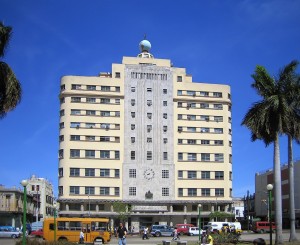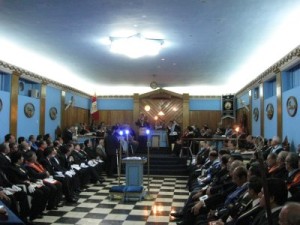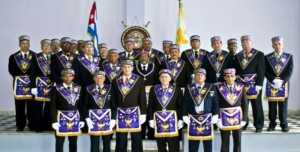THE MASONIC SOCIETY IN CUBA.
The rich Masonic history of Cuba is so extensive that we are forced to show in this drafting a summary of all the same, that is the most relevant points that allow us to show the world how big it was, is and will be our fraternity in Cuba. Freemasonry is not a political organization, but sometimes its members were persecuted for political reasons. Nor is it a religious sect, even its adherents admit swear to their principles. In the past the Catholic Church treated them as heretics and many monarchies they considered a fatal threat to their crowns by his insistent vocation to oppose any religious or political tyranny.
However, even today, when humanity seems to have lost his sanity, the Masons meet and work regularly in hopes of redeeming.
But surely, Freemasonry has left behind his most glorious moments when the names of great writers, musicians, and thinkers prestigiaban their ranks. Far it has been that golden age when Mozart wrote his Masonic cantata “Praise to friendship”, inspired by the ideals of brotherhood, or the revolutionaries of 89 French chanted through the streets of Paris Mason motto Liberté, Egalité, fraternité. But since George Washington to Benito Juarez (not forgetting Walt Disney) is undeniable social influence it has had this fraternal association in modern history.
Freemasonry in Cuba also has an illustrious past, inextricably linked to the very formation of nationality and militated in its ranks men who then fought for independence.
Perhaps many think their ancient rites and liturgies not they in line with the postmodern world and that, as an institution that aims to achieve the betterment of society, but not promote social changes, is obsolete. Paradoxically, Freemasonry on the island now has a growing membership, which is not idle reflect on the role of this institution in the history of the nation and its undeniable resurgence today.
Article I, paragraph I of the Masonic Cuban Constitution states that “Masonry is organic institution of morality,” moral understood as respect for themselves and the society in which it stands, and this criterion represents the aspiration a lifestyle to be distinguished by the Masons, not only within the fraternity, but also in any environment where it is located.
Freemasonry and Cuba 1959 revolution.
During the early years Freemasonry supports the new government and its revolutionary measures, but the radicalization of the process results in some of its top officials leave the country. Former teacher JJ Tarajano cover -Large US Grand Lodge of Cuba in exile, which was recognized by the Conference of Grand Masters held in Washington.
Cuban Masons claim that the Grand Lodge based in Havana is the only true representation of the Cuban regular masonry and this is finally recognized in the V Conference of the Inter-American Masonic Confederation.
At this time Freemasonry began to face difficulties: significantly reduced their financial resources were limited and many of his private philanthropic efforts, due to the profound changes in the country. To this is added the exodus to the outside of some of its members, while very few young people are interested in joining the institution and preferred to devote himself to a process that promised to fulfill more than anything that the Masons have always raised as mostly motto: “Liberty, Equality, Fraternity”. 34 thousand members in 1959, the figure had dropped to 19,582 in 1981. But when it seemed that the fate of Freemasonry in Cuba was quietly languish until its total extinction, start registering signs of recovery. From 1982 a slight growth not be halted until the present, when your membership totals more than 28,000 members are warned.
In recent years he has it grown significantly international participation of Masonry of Cuba and the recognition received in the universal concert of the institution: the Grand Lodge of Cuba (through its then Grand Master) exerted the vice Confederation Inter-American Masonic years ago, presiding over the second zone comprising the Caribbean Regular Grand Lodges.
Masons are confident that, despite their ancient rituals, Freemasonry is not anachronistic: the ethics of its principles, its collectivism and because their purpose to seek improvement of man is inexhaustible. From this comes, optimistic in assessing the future of Freemasonry in Cuba, “… the institution that has provided elements of independence, freedom, culture and progress of Cuba …”
Grand Lodge of Cuba, Havana / InternetPhotos / Excerpts / TheCubanHistory.com
The Cuban History / Hollywood.
Arnoldo Varona, Editor.
LA SOCIEDAD MASÓNICA EN CUBA.
La rica historia masónica de Cuba es tan extensa que nos vemos obligados a mostrar en esta redacción un resumen de la totalidad de los mismos, o sea los puntos más relevantes, que nos permiten mostrar al mundo lo grande que ha sido, es y será nuestra fraternidad en Cuba. La masonería no es una organización política, aunque en ocasiones sus miembros fueron perseguidos por causas políticas. Tampoco es una secta religiosa, aunque sus adeptos confiesan una fe absoluta hacia sus principios. En el pasado la Iglesia Católica los trató como a herejes y muchas monarquías los consideraban una amenaza fatal para sus coronas por su insistente vocación de oponerse a cualquier tiranía religiosa o política.
Sin embargo, todavía hoy, cuando la humanidad parece haber perdido su cordura, los masones se reúnen y trabajan regularmente con la esperanza de redimirla.
Pero, indudablemente, la masonería ya ha dejado atrás sus momentos más gloriosos, cuando los nombres de grandes literatos, músicos, y pensadores prestigiaban sus filas. Muy lejos ha quedado aquella época dorada en que Mozart escribía su cantata masónica “El elogio a la amistad”, inspirado en los ideales de la hermandad, o los revolucionarios del 89 franceses gritaban por las calles de París el lema masón de Liberté, Egalité, Fraternité. Pero desde George Washington a Benito Juárez (sin olvidar a Walt Disney) es innegable la influencia social que ha tenido esta asociación fraternal en la historia moderna.
En Cuba la masonería también cuenta con un pasado ilustre, indisolublemente ligado a la formación misma de la nacionalidad y en sus filas militaron los hombres que luego lucharon por la independencia del país.
Quizás muchos piensen que sus antiguos ritos y liturgias ya no se avienen con el mundo postmoderno y que, como institución que se propone alcanzar el mejoramiento de la sociedad, aunque sin propiciar cambios sociales, ya resulta obsoleta. Paradójicamente, la masonería en la isla tiene ahora una membresía creciente, por lo que no resulta ocioso reflexionar sobre el papel de esta institución en la historia de la nación y su innegable resurgimiento en la actualidad.
El artículo primero, inciso I de la Constitución Masónica Cubana declara que “La masonería es la institución orgánica de la moralidad”, la moral entendida como el respeto a sí mismo y a la sociedad en la que se asienta, y este criterio representa la aspiración a un estilo de vida por el que deben distinguirse los masones, no sólo dentro de la fraternidad, sino también en cualquier medio donde se encuentre.
LA MASONERIA Y LA REVOLUCIÓN DE 1959.
Durante los primeros años la masonería respalda al nuevo gobierno y sus medidas revolucionarias, pero la radicalización del proceso trae como resultado que algunos de sus altos funcionarios abandonen el país. El Ex -Gran maestro J. J. Tarajano funda en Estados Unidos la Gran Logia de Cuba en el exilio, que fue reconocida en la Conferencia de Grandes Maestros celebrada en Washington.
Los masones cubanos proclaman que la Gran Logia con sede en La Habana es la única y verdadera representación de la masonería regular cubana y este hecho finalmente es reconocido en la V Conferencia de la Confederación Masónica Interamericana.
En esta época la Masonería comienza a enfrentar dificultades: disminuyeron sensiblemente sus recursos financieros y vieron limitadas muchas de sus gestiones filantrópicas de carácter privado, debido a los profundos cambios ocurridos en el país. A esto se suma el éxodo hacia el exterior de una parte de sus miembros, mientras que muy pocos jóvenes se interesaban por ingresar en la institución y preferían dedicarse por entero a un proceso que prometía cumplir con creces todo aquello que los masones han enarbolado siempre como su mayor divisa: “Libertad, Igualdad, Fraternidad”. De 34 mil miembros en 1959, la cifra se había reducido a 19.582 en 1981. Pero cuando parecía que el destino de la masonería en Cuba era languidecer calladamente hasta su total extinción, comienzan a registrarse signos de recuperación. A partir de 1982 se advierte un ligero crecimiento que ya no se detendrá hasta el presente, cuando su membresía asciende a más de 28 mil afiliados.
En los últimos años ha crecido de manera significativa la participación internacional de la Masonería de Cuba y el reconocimiento que recibe en el concierto universal de la Institución : la Gran Logia de Cuba (por medio de su entonces Gran Maestro) ejerció la Vicepresidencia de la Confederación Masónica Interamericana años atrás, presidiendo la Segunda Zona que comprende las Grandes Logias Regulares del Caribe.
Los masones están seguros de que, a pesar de sus antiguos ritos, la masonería no resulta anacrónica: por la ética de sus postulados, por su colectivismo y porque su finalidad de buscar la superación del hombre es inagotable. De ahí proviene, su optimismo al valorar el futuro de la masonería en la Isla, “…la institución que más elementos ha aportado a la independencia, la libertad, la cultura y el progreso de Cuba…”
Gran Logia de Cuba, La Habana/InternetPhotos/Excerpts/TheCubanHistory.com
The Cuban History/ Hollywood.
Arnoldo Varona, Editor.



 THE MASONIC Society in Cuba. + LA SOCIEDAD Masónica en Cuba.
THE MASONIC Society in Cuba. + LA SOCIEDAD Masónica en Cuba.



